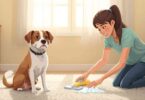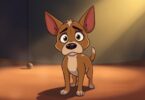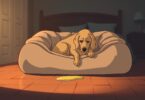Could your furry friend’s paw-chewing habit signal something deeper than a quirky behavior? Many pet owners notice their dogs repeatedly licking or nibbling at their paws, but the reasons behind this action often remain a mystery. This common behavior in Bichon Frises and other breeds can stem from physical discomfort, emotional distress, or even environmental triggers.
Dogs may chew their paws due to allergies, skin irritation, or infections. Seasonal changes, household cleaners, or certain foods can trigger reactions that lead to persistent biting. Flea bites or fungal growth between the toes might also cause discomfort, prompting your pet to seek relief through chewing.
Emotional factors like stress or anxiety play a role too. Changes in routine, loud noises, or separation from owners can heighten nervous behaviors. For Bichon Frises—a breed known for forming strong bonds—prolonged alone time might result in paw-focused coping mechanisms.
This article explores both medical and psychological causes behind this puzzling habit. You’ll learn to identify warning signs, discover vet-approved solutions, and find ways to support your companion’s physical and emotional health. Let’s decode the messages behind those tiny teeth marks together.
Common Physical Triggers in Bichon Frise Behavior
When your fluffy companion starts gnawing at their paws, it might be more than just a quirky habit. Physical discomfort often drives this behavior, with allergies ranking as a top concern. Reactions to ingredients in their food or environmental elements like pollen can make paws itch relentlessly.
Hidden Irritants and Health Concerns
Skin infections between toe pads create persistent itching. Moisture trapped in thick fur breeds yeast or bacteria, leading to redness and inflammation. Flea bites near the paws also trigger intense chewing—check between toes for tiny black specks or swelling.
Household Hazards and Inspection Tips
Everyday products like floor cleaners or lawn chemicals can irritate sensitive paw pads. Use a flashlight to examine their feet—look for cracked skin, foreign objects, or rashes. Persistent licking or visible sores? Schedule a vet visit to rule out infections or parasites.
Early intervention prevents minor issues from escalating. A professional can recommend hypoallergenic diets, medicated shampoos, or flea prevention strategies tailored to your pet’s needs.
Emotional and Environmental Factors Affecting Biting
Behind those tiny teeth marks could lie hidden emotional struggles. Intelligent breeds like the Bichon Frise often develop habits like paw chewing when their mental or emotional needs go unmet. Recognizing these triggers helps create a supportive environment for sensitive companions.
Stress, Separation Anxiety, and Overstimulation
Loud noises, schedule changes, or prolonged isolation can overwhelm dogs. Many Bichon Frises resort to biting their paws as a self-soothing ritual during stressful events. A study on stress-related chewing shows this behavior often peaks when owners leave home.
Watch for patterns: Does your pet target their paws after thunderstorms or during workdays? These clues help identify anxiety sources. Calming aids like pheromone diffusers or cozy retreats can ease tension.
Boredom and Lack of Mental Stimulation
Without engaging activities, dogs invent their own entertainment—often destructive. Puzzle feeders and training games channel energy positively. A 20-minute sniffing walk tires minds faster than hour-long physical exercise.
Rotate toys weekly to maintain novelty. Food-dispensing balls or scent games satisfy the Bichon Frise’s curious nature. Pair these with consistent routines to build confidence and reduce attention-seeking nibbles.
Unraveling the Mystery: why does bichon frize bit my feet
Have you ever wondered what your Bichon Frise is trying to communicate through their playful nips? Beyond physical discomfort, these actions often reveal fascinating behavioral patterns rooted in canine instincts and social dynamics.
Instinctual Herding and Playful Nipping
Though not traditional herders, some Bichon Frises display nipping behaviors reminiscent of working breeds. This playful mimicry often surfaces during energetic moments. Your pet might gently mouth at ankles or shoes as an invitation to interact—like initiating a game of chase.
Research shows even companion breeds retain ancestral traits. These light nips rarely cause harm but signal excitement. Watch for accompanying cues: a wagging tail, bouncing movements, or excited barks often accompany this type of interaction.
Behavioral Cues and Attention-Seeking Signals
Persistent foot-targeted behavior sometimes shouts, “Notice me!” Dogs learn quickly which actions earn reactions. A sudden nibble during work hours might simply mean your companion wants engagement.
Key strategies help redirect this energy:
• Freeze movement when nibbling starts—removing the “game” aspect
• Offer chew toys as approved alternatives
• Reward calm behavior with affection or treats
Understanding these natural signals helps owners respond effectively. Consistent training paired with interactive play sessions often reduces unwanted biting while strengthening your bond.
Practical Solutions and Expert Tips for Pet Owners
Managing persistent paw-focused behavior requires a blend of quick responses and long-term strategies. Start by calmly interrupting the action—gently lift your companion away from their paws without scolding. Check for visible redness, debris, or swelling between toes using a soft cloth and natural light.
Immediate Actions and Safe Distraction Techniques
Keep interactive toys nearby to redirect chewing urges. A frozen carrot or rubber puzzle filled with peanut butter provides satisfying texture. Reward calm behavior immediately—say “good settle” while offering a low-calorie treat. This reinforces positive habits without encouraging overexcitement.
For environmental triggers, wipe paws after walks using hypoallergenic wipes. Switch to fragrance-free cleaning products if licking increases post-floor mopping. Rotate toys weekly to combat boredom-driven chewing.
When to Consult Your Veterinarian or Trainer
Persistent biting despite interventions warrants professional insight. Vets can test for allergies or skin infections through scrapings and bloodwork. Trainers address separation anxiety using desensitization exercises—like practicing short departures with calming music.
Seek help if you notice hair loss, open sores, or obsessive licking. Combined veterinary care and behavior modification often resolve complex cases. Tailored solutions improve both physical comfort and emotional balance for happier pets.
Wrapping Up and Moving Forward with Your Pet’s Well-Being
Understanding your dog’s paw-focused habits unlocks better care strategies. Physical triggers like allergies or skin infections often drive persistent chewing, while emotional needs or environmental stressors can deepen the behavior. Addressing both aspects creates lasting solutions.
Regularly inspect paws for redness or irritation. Swap harsh household products for pet-safe alternatives to reduce chemical exposure. For ongoing issues, consult a vet to identify allergies or infections early. Pair medical care with mental enrichment—interactive toys and routine changes combat boredom effectively.
Track patterns in your dog’s environment. Does chewing spike after loud events or during alone time? Tools like targeted paw care routines and anxiety-reducing techniques can break the cycle. Consistent training builds trust while redirecting unwanted biting.
Every pet deserves a balanced approach. Combine observation, professional guidance, and tailored interventions. With patience and the right tools, you’ll nurture healthier habits and strengthen your bond. Start today—small steps lead to big improvements in their quality of life.










Leave a Comment